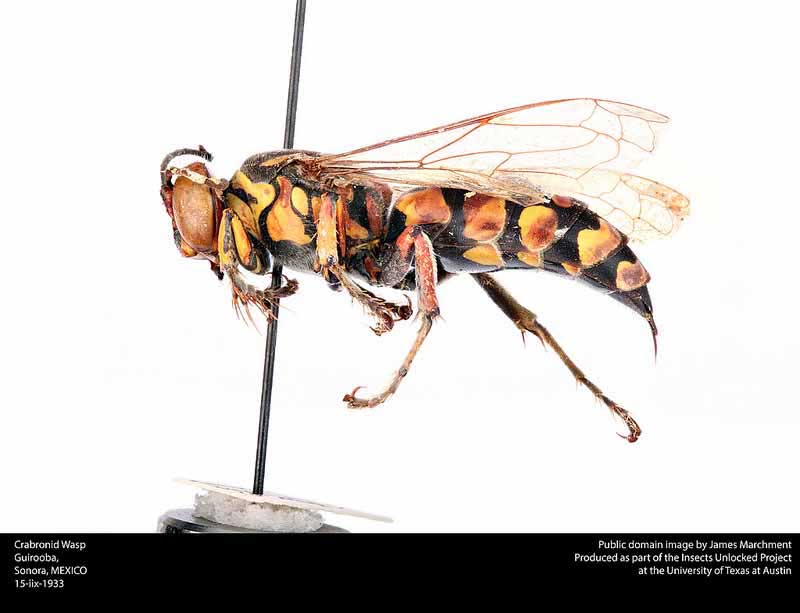
Superregnum: Eukaryota
Cladus: Unikonta
Cladus: Opisthokonta
Cladus: Holozoa
Regnum: Animalia
Subregnum: Eumetazoa
Cladus: Bilateria
Cladus: Nephrozoa
Cladus: Protostomia
Cladus: Ecdysozoa
Cladus: Panarthropoda
Phylum: Arthropoda
Subphylum: Hexapoda
Classis: Insecta
Cladus: Dicondylia
Subclassis: Pterygota
Cladus: Metapterygota
Infraclassis: Neoptera
Cladus: Eumetabola
Cladus: Endopterygota
Superordo: Hymenopterida
Ordo: Hymenoptera
Subordo: Apocrita
Superfamilia: Apoidea
Familia: Crabronidae
Subfamiliae: Astatinae - Bembicinae - Crabroninae - Dinetinae - Eremiaspheciinae - Mellininae - Pemphredoninae - Philanthinae
Overview of genera (9)
Bembix – Cerceris – Crossocerus – Liris – Microbembex – Pemphredon – Philanthus – Sphecius – Stictia
[source: Catalogue of Life: 2012 Annual Checklist] [very incomplete!]
Clitemnestra – Krombeinictus – Larrissa – Larrisson – ...
Name
Crabronidae Latreille, 1802
References
Latreille, P.A. 1802. Histoire naturelle, générale et particulière des crustacés et des insectes. Ouvrage faisant suite à l’histoire naturelle générale et particulière, composée par Leclerc de Buffon, et rédigée par C.S. Sonnini, membre de plusieurs sociétés savantes. Familles naturelles des genres. Tome troisième. F. Dufart, Paris, xii + pp. 13–467 + [1 (errata)]. BHL Reference page.
Jahantigh, F., Rakhshani, E., Mokhtari, A. & Ramroodi, S. 2017. Catalogue of Ampulicidae, Crabronidae and Sphecidae of Iran (Hymenoptera, Apoidea). Zootaxa 4307(1): 1–96. DOI: 10.11646/zootaxa.4307.1.1. Reference page.
Vernacular names
日本語: ギングチバチ科
The Crabronidae are a large paraphyletic group (nominally a family) of wasps, including nearly all of the species formerly comprising the now-defunct superfamily Sphecoidea. It collectively includes well over 200 genera, containing well over 9000 species. Crabronids were originally a part of Sphecidae, but the latter name is now restricted to a separate family based on what was once the subfamily Sphecinae. Several of the subfamilies of Crabronidae are often treated as families in their own right, as is true of the most recent phylogenies (example below).
Phylogeny
This phylogenetic tree is based on Sann et al., 2018, which used phylogenomics to demonstrate that both the bees (Anthophila) and the Sphecidae arose from within the former Crabronidae, which is therefore paraphyletic, and which they suggested should be split into several families; the former family Heterogynaidae nests within the Bembicidae, as here defined.[1] These findings differ in several details from studies published by two other sets of authors in 2017, though all three studies demonstrate a paraphyletic "Crabronidae."[2][3] Only three of these lineages were not included within Crabronidae in the past: Ampulicidae, Sphecidae, and Anthophila.
| Apoidea |
|
Subgroups
Subfamily Astatinae (now ranked as a family)
Astata, etc.
Subfamily Bembicinae (now ranked as a family)
Tribe Alyssontini
Tribe Bembicini
Bembix Fabricius 1775
Zyzzyx Pate 1937, etc.
Tribe Gorytini
Gorytes Latreille, 1804
Sphecius, etc.
Tribe Heliocausini
Tribe Nyssonini
Tribe Stizini
Subfamily Crabroninae (incl. Eremiaspheciinae and Dinetinae)
Aha
Crabro
Dalara
Liris
Pison, etc.
Subfamily Mellininae (now ranked as a family)
Mellinus
Xenosphex
Subfamily Pemphredoninae (recently split into three families)
Microstigmus
Lithium
Pemphredon, etc.
Subfamily Philanthinae (now ranked as a family)
Cerceris
Philanthus, etc.
Life cycle
Trypoxylon collinum larva
Trypoxylon collinum pupa
Trypoxylon collinum adult
See also
List of Crabronidae genera
References
Sann, Manuela; Niehuis, Oliver; Peters, Ralph S.; Mayer, Christoph; Kozlov, Alexey; Podsiadlowski, Lars; Bank, Sarah; Meusemann, Karen; Misof, Bernhard; Bleidorn, Christoph; Ohl, Michael (2018). "Phylogenomic analysis of Apoidea sheds new light on the sister group of bees". BMC Evolutionary Biology. 18 (1): 71. doi:10.1186/s12862-018-1155-8. PMC 5960199. PMID 29776336.
Branstetter, Michael G.; Danforth, Bryan N.; Pitts, James P.; Faircloth, Brant C.; Ward, Philip S.; Buffington, Matthew L.; Gates, Michael W.; Kula, Robert R.; Brady, Seán G. (2017). "Phylogenomic Insights into the Evolution of Stinging Wasps and the Origins of Ants and Bees". Current Biology. 27 (7): 1019–1025. doi:10.1016/j.cub.2017.03.027. PMID 28376325.
Peters, Ralph S.; Krogmann, Lars; Mayer, Christoph; Donath, Alexander; Gunkel, Simon; Meusemann, Karen; Kozlov, Alexey; Podsiadlowski, Lars; Petersen, Malte (2017). "Evolutionary History of the Hymenoptera". Current Biology. 27 (7): 1013–1018. doi:10.1016/j.cub.2017.01.027. PMID 28343967.
Sources
Catalog of Sphecidae sensu lato at Cal Academy
Retrieved from "http://en.wikipedia.org/"
All text is available under the terms of the GNU Free Documentation License

